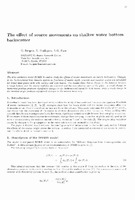| dc.contributor.author | Bergem, Oddbjorn | |
| dc.contributor.author | Pouliquen, Eric | |
| dc.contributor.author | Pace, Nicholas G. | |
| dc.date.accessioned | 2018-10-11T14:08:06Z | |
| dc.date.available | 2018-10-11T14:08:06Z | |
| dc.date.issued | 1997 | |
| dc.identifier | 11438 | |
| dc.identifier.govdoc | CP-45 | |
| dc.identifier.uri | http://hdl.handle.net/20.500.12489/398 | |
| dc.description.abstract | The time-evolution model BORIS is used to study the effects of source movements on bottom backscatter. Changes in the backscattend time domain signals as functions of source depth, position and incident angles are simulated for broad band pulses both with namw and wide beams. The results show that a change in the distance between a rough bottom and the source modifies the coherent and the non-coherent part of the pulse. A small change in horizontal position produces significant changes in the backscattered signal for both beams, while a small change to the incident angle produces significant changes in the narrow beam only. | |
| dc.format | 6 p. : ill. ; digital, PDF file | |
| dc.language | English | |
| dc.publisher | NATO. SACLANTCEN | |
| dc.source | In: High Frequency Seafloor Acoustics (SACLANTCEN Conference Proceedings CP-45), 1997, pp. 25-30 | |
| dc.subject | BORIS (Bottom Response from Inhomogeneities and Surface) model | |
| dc.subject | Shallow water | |
| dc.subject | Acoustic scattering - Seafloor and sea surface | |
| dc.subject | Seafloor characterization | |
| dc.title | The effect source movements on shallow water bottom backscatter | |
| dc.type | Papers and Articles | |
| dc.type | Conference Proceedings (CP) | |
